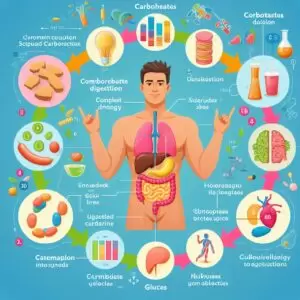In today’s fast-paced world, where convenience often trumps quality, understanding the basics of nutrition has never been more critical. At the core of this understanding are macronutrients: proteins, fats, and carbohydrates, the essential building blocks that fuel our bodies, support growth, repair tissues, and maintain vital functions. But what exactly are macronutrients, and why are they so important? This Essential Guide to Macronutrients offers an in-depth look into the roles and significance of proteins, fats, and carbohydrates, shedding light on how to balance these nutrients for a healthier, more vibrant life. As we delve into the science and function behind each macronutrient, you’ll gain insights into crafting a diet that not only nourishes your body but also supports your overall well-being.
From the importance of amino acids in proteins to the energy-providing power of carbohydrates and the vital roles of different fats, this guide is your comprehensive resource for understanding and optimizing your dietary choices. Embrace the journey toward optimal health as we explore the fascinating world of macronutrients, and learn how to make informed decisions that benefit your body, mind, and spirit.
I. Proteins: The Essential Building Blocks for a Healthy Body.

Proteins stand as the cornerstone of a nutritious diet, pivotal not only for the growth, repair, and maintenance of body tissues but also as the fundamental components that ensure the smooth operation of various biological processes. At the heart of proteins are amino acids, often hailed as the body’s fundamental building blocks, playing a critical role in constructing muscles, organs, and many other elements necessary for life.
1. Understanding Proteins and Their Importance:
Proteins are intricate molecules that perform a myriad of functions within the body. They contribute to the structural integrity of cells, facilitate metabolic reactions, coordinate bodily functions, and bolster the immune system against pathogens. Essentially, proteins are indispensable for the development and repair of muscles, organs, skin, hair, and other tissues, underscoring their significance in maintaining overall health and well-being.
2. The Role of Amino Acids:
Amino acids, the individual units that compose proteins, are crucial for a plethora of bodily functions. Twenty different amino acids combine in various ways to create proteins. These amino acids are categorized into essential, which must be obtained through diet as the body cannot synthesize them, and non-essential, which the body can produce. This diversity in amino acid composition allows proteins to fulfill their extensive range of functions.
3. The Impact of Proteins on Muscle Repair and Growth:
One of the most recognized benefits of protein is its contribution to muscle repair and growth. Following exercise or any physical activity that strains muscle tissues, proteins help repair the minor tears that occur, promoting muscle growth over time. This process is crucial for athletes, bodybuilders, and anyone engaged in regular physical activity to improve strength and endurance.
4. Proteins in Hormone Production and Immune Function:
Beyond muscle repair, proteins are integral to hormone production and regulation. Hormones, which serve as chemical messengers in the body, facilitate communication between various organs and systems. Proteins are involved in the creation of hormones such as insulin, which regulates blood sugar levels, and growth hormones, which play a role in controlling the body’s growth and metabolism.
Furthermore, proteins are vital for a robust immune system. Antibodies, a type of protein, are essential in fighting off infections by identifying and neutralizing pathogens like bacteria and viruses. This defensive mechanism is critical for maintaining health and preventing illnesses.
5. Incorporating Protein into Your Diet:
To harness the benefits of proteins, incorporating a healthy amount of protein into your diet is essential. High-quality protein sources include:
– Lean Meats: Chicken, turkey, and lean cuts of beef and pork provide high amounts of protein with lower fat content.
– Dairy Products: Milk, cheese, and yogurt are excellent sources of protein and contain calcium and vitamin D, which are vital for bone health.
– Legumes: Beans, lentils, and chickpeas offer plant-based proteins and are rich in fiber, vitamins, and minerals.
– Nuts and Seeds: Almonds, walnuts, flaxseeds, and chia seeds are not only protein-rich but also provide healthy fats and omega-3 fatty acids.
By selecting a variety of protein sources, individuals can enjoy a balanced diet that supports muscle growth, repairs tissues, and maintains overall health and vitality.
Proteins are more than just dietary components; they are essential nutrients that play critical roles in almost every function within the body. Understanding the importance of proteins and integrating high-quality sources into your diet can lead to improved health, stronger muscles, and a more robust immune system.
II. Carbohydrates: The Primary Energy Source.

Carbohydrates stand as the primary fuel for the body, providing the energy needed for all physical activities, from the most mundane tasks to the most intense physical exertions. They are not just any energy source; they are the body’s preferred source, especially for the brain, which relies heavily on glucose, a simple sugar derived from carbohydrates, for optimal function. Understanding the vital role carbohydrates play in maintaining health and energy levels is crucial for anyone looking to optimize their diet for better health and performance.
1. Understanding Carbohydrates and Their Role:
Carbohydrates are classified into two main types: simple carbohydrates (sugars) and complex carbohydrates (starches and fibers). This classification is based on their chemical structure and how quickly they are digested and absorbed by the body. Simple carbohydrates, found in foods like candy, soda, and syrups, are quickly broken down into glucose, providing a rapid energy boost. However, this quick fix is often followed by a swift drop in energy levels, leading to a cycle of highs and lows.
Complex carbohydrates, on the other hand, are found in foods such as whole grains, vegetables, fruits, and legumes. These carbohydrates are composed of longer chains of sugar molecules, which means they take longer to break down. As a result, they provide a more sustained source of energy without the spikes and crashes associated with simple sugars. Moreover, complex carbohydrates come packed with vitamins, minerals, and fibers, adding numerous health benefits beyond just energy provision.
2. The Importance of Dietary Fiber:
A significant benefit of complex carbohydrates is their fiber content. Fiber, an indigestible part of plant foods, plays a pivotal role in digestive health. It helps to keep the digestive system running smoothly, can prevent constipation, and may lower the risk of developing diseases such as diabetes and heart disease. Furthermore, high-fiber foods tend to be more filling, which can help in weight management by reducing the overall calorie intake.
3. Sources of Complex Carbohydrates:
To harness the full power of carbohydrates for sustained energy and health, focusing on complex carbohydrates is key. Some of the richest sources include:
– Whole Grains: Options like brown rice, quinoa, oats, and whole wheat products are not only excellent sources of energy but also contain essential nutrients like B vitamins, iron, and magnesium.
– Vegetables: Especially those that are leafy and green, vegetables are packed with vitamins, minerals, and antioxidants in addition to carbohydrates and fiber.
– Fruits: While fruits contain simple sugars, they are also rich in fiber, vitamins, and water, making them a healthier choice for a sweet craving.
– Legumes: Beans, lentils, and peas are high in protein, fiber, and complex carbohydrates, making them an excellent addition to any diet.
Incorporating a variety of these foods into your daily meals can ensure a steady supply of energy throughout the day, improve digestive health, and contribute to an overall balanced diet.
3. Balancing Carbohydrates in Your Diet:
While carbohydrates are essential for energy, balance is key to a healthy diet. Opting for complex carbohydrates over simple sugars where possible can prevent energy spikes and promote long-term health benefits. Additionally, considering the portion size and combining carbohydrates with proteins and healthy fats can help stabilize blood sugar levels and provide sustained energy.
Carbohydrates are indispensable as the body’s main energy source. By understanding the types of carbohydrates and focusing on complex carbohydrates rich in fiber, individuals can improve their energy levels, support brain function, and enhance digestive health. A balanced approach to carbohydrate intake is fundamental to achieving a nutritious diet and maintaining optimal health and well-being.
III. Fats: Vital for Health.

Fats, long stigmatized and misunderstood, play an indispensable role in maintaining and promoting health. Far from being dietary villains, fats are vital for numerous bodily functions, including nutrient absorption, energy provision, nerve transmission, and the maintenance of cell membrane integrity. They are the body’s most concentrated source of energy, providing more than double the energy per gram compared to carbohydrates or proteins. Understanding the different types of fats and their roles in health can empower individuals to make informed dietary choices, improving their overall wellness.
1. The Critical Functions of Fats in the Body:
Fats are not just a source of energy; they are crucial for the absorption of fat-soluble vitamins (A, D, E, and K), which play key roles in vision, bone health, antioxidant functions, and blood clotting. Additionally, fats are integral to the structure and function of cell membranes, ensuring fluidity and facilitating the passage of substances in and out of cells. They also contribute to the myelin sheath, a fatty layer that surrounds and insulates nerve fibers, ensuring efficient transmission of nerve impulses.
Fats are involved in the production of essential hormones and inflammatory mediators, which are vital for maintaining homeostasis and responding to injuries and infections. This highlights the complexity of fats’ roles in the body and underscores their importance in a balanced diet.
2. Understanding the Types of Fats:
Fats are categorized into three main types: saturated, unsaturated, and trans fats, each with different sources and impacts on health:
– Saturated Fats: Commonly found in animal products (such as meat and dairy) and some plant-based sources (like coconut oil), saturated fats are solid at room temperature. While they are an essential part of the diet, excessive intake has been associated with increased levels of LDL (low-density lipoprotein) cholesterol, a risk factor for heart disease. Moderation is key when consuming saturated fats.
– Unsaturated Fats: These are considered the healthiest fats, found in plant sources like avocados, olive oil, and nuts, as well as in fatty fish. Unsaturated fats are liquid at room temperature and can be divided into monounsaturated and polyunsaturated fats, including omega-3 and omega-6 fatty acids. They contribute to lowering LDL cholesterol and increasing HDL (high-density lipoprotein) cholesterol, supporting heart health and reducing inflammation.
– Trans Fats: Often found in processed foods, trans fats are created by adding hydrogen to liquid vegetable oils (a process known as hydrogenation) to make them more solid. They are associated with numerous health risks, including increased LDL cholesterol, decreased HDL cholesterol, inflammation, and a higher risk of heart disease. Minimizing or eliminating trans fats from the diet is recommended for health.
3. Incorporating Healthy Fats into Your Diet:
To benefit from fats while maintaining health, focusing on the source and type of fat is crucial. Incorporating a variety of unsaturated fats from both plant and fish sources can improve heart health, reduce inflammation, and support overall well-being. Here are some tips for including healthy fats in your diet:
– Choose Sources of Unsaturated Fats: Incorporate foods like avocados, nuts, seeds, olive oil, and fatty fish (such as salmon, mackerel, and sardines) into your meals.
– Moderate Intake of Saturated Fats: Opt for lean cuts of meat, low-fat dairy products, and plant-based alternatives when possible.
– Avoid Trans Fats: Read labels to avoid products containing partially hydrogenated oils, commonly found in processed and fried foods.
Understanding the role and types of fats is essential for making informed dietary choices. By focusing on unsaturated fats and limiting saturated and trans fats, individuals can enjoy the numerous health benefits fats offer without compromising their health. Balancing fat intake is not about elimination but about making mindful choices that support your body’s needs and promote overall health.
IV. Balancing Macronutrients for Optimal Health:

Achieving optimal health requires more than just focusing on calories; it demands a balanced intake of the three macronutrients: carbohydrates, proteins, and fats. These macronutrients serve as the foundation of a healthy diet, each playing unique and essential roles in body function and overall well-being. While individual needs may vary based on factors such as health goals, activity levels, and metabolic health, understanding how to balance these macronutrients can help you create a nutritious, varied, and satisfying diet.
1. The Importance of Macronutrient Balance:
Each macronutrient has its specific functions and benefits:
– Carbohydrates provide the body with its primary energy source, supporting brain function, nervous system activity, and physical exertion.
– Proteins are crucial for building and repairing tissues, supporting immune function, and contributing to hormonal and enzyme production.
– Fats are essential for absorbing vitamins, protecting organs, providing energy, and supporting cell growth.
Balancing these macronutrients is not about strict ratios or eliminating any group. Instead, it’s about understanding their roles and ensuring your diet includes a diverse range of foods that contribute to your health and energy levels.
2. General Guidelines for Macronutrient Balance:
A practical approach to balancing macronutrients involves visualizing your plate at each meal:
– Half of Your Plate: Fruits and Vegetables. This portion provides essential vitamins, minerals, fiber, and antioxidants that support various bodily functions, including digestion and immune health. Aiming for a variety of colors ensures a broad range of nutrients.
– One-Quarter of Your Plate: Protein. Quality sources of protein include lean meats, fish, dairy, legumes, and nuts. Proteins are fundamental for muscle repair, growth, and maintaining a healthy metabolism.
– One-Quarter of Your Plate: Whole Grains. Foods such as brown rice, quinoa, oats, and whole wheat products offer complex carbohydrates for sustained energy, along with fiber, vitamins, and minerals.
3. Paying Attention to Quality:
The quality of the macronutrients you choose is as important as their quantity:
– Choose Whole, Unprocessed Foods: These foods are closer to their natural state and tend to be more nutrient-dense and less calorie-dense than their processed counterparts.
– Opt for Healthy Fats: Incorporate sources of unsaturated fats, like avocados, nuts, seeds, and olive oil, while limiting saturated fats and avoiding trans fats.
– Select High-Quality Proteins: Favor lean meats, poultry, fish, and plant-based proteins, ensuring variety and balance.
– Pick Complex Carbohydrates: Opt for whole grains and legumes over refined grains and sugar-rich foods to benefit from their full nutritional profile, including fiber.
3. Customizing Your Macronutrient Balance:
It’s important to remember that there’s no one-size-fits-all approach to macronutrient balance. Factors such as age, sex, weight, activity level, and specific health goals can all influence the optimal macronutrient ratio for an individual.
Listening to your body and possibly consulting with a healthcare provider or a registered dietitian can help tailor the general guidelines to your personal needs, ensuring you receive the right balance of nutrients to support your health and lifestyle.
Balancing macronutrients is a dynamic process that involves thoughtful choices and a focus on food quality. By visualizing your plate and aiming for a diverse intake of carbohydrates, proteins, and fats from whole, unprocessed sources, you can support your body’s needs and work towards achieving optimal health. Remember, flexibility and moderation are key to a sustainable and healthy diet.
V. The Role of Micronutrients:

When optimizing your diet for health and wellness, it’s crucial to consider not just the macronutrients—carbohydrates, proteins, and fats but also the micronutrients: the vitamins and minerals that support the body’s diverse and intricate processes. Micronutrients, though required in smaller quantities than macronutrients, are vital for the proper functioning of the body, acting as the unsung heroes in maintaining health and preventing diseases. Understanding the critical roles these nutrients play can empower individuals to make informed dietary choices that enhance their overall well-being.
1. Understanding Micronutrients:
Micronutrients encompass a broad spectrum of vitamins and minerals, each with unique functions:
– Vitamins: Organic compounds required in small amounts for growth, reproduction, and the maintenance of good health. Vitamins are classified into water-soluble (B vitamins and vitamin C) and fat-soluble (vitamins A, D, E, and K) categories, each playing distinct roles in bodily functions.
– Minerals: Inorganic elements that serve structural and functional roles in the body. Major minerals include calcium, phosphorus, potassium, sodium, and magnesium, crucial for bone health, fluid balance, and muscle function. Trace minerals, needed in smaller amounts, include iron, zinc, copper, and selenium, important for enzyme function, immune response, and wound healing.
2. The Impact of Micronutrients on Health:
Micronutrients play pivotal roles in nearly every bodily function and process, including:
– Supporting Immune Function: Vitamins A, C, D, and minerals like zinc and selenium are crucial for maintaining a robust immune system, protecting the body against infections and illnesses.
– Enhancing Bone Health: Calcium, vitamin D, and phosphorus are key to developing and maintaining strong bones, reducing the risk of osteoporosis and fractures.
– Boosting Brain Function: B vitamins, particularly B12, and antioxidants like vitamins C and E, support brain health, enhancing memory, focus, and cognitive function.
– Promoting Heart Health: Minerals like potassium and magnesium help regulate blood pressure, while antioxidants protect against vascular damage, supporting overall cardiovascular health.
3. Incorporating Micronutrients into Your Diet:
A balanced diet rich in fruits, vegetables, whole grains, lean proteins, and healthy fats is the best way to ensure adequate intake of essential micronutrients. Here are some strategies to enhance your micronutrient consumption:
– Eat a Rainbow: Consuming a variety of fruits and vegetables in all colors ensures a broad range of vitamins and minerals, each color offering different health benefits.
– Choose Whole Foods: Whole, unprocessed foods are more nutrient-dense, providing a richer source of vitamins and minerals compared to processed foods.
– Consider Supplementation Wisely: In some cases, supplementation may be necessary to meet the body’s needs, especially for nutrients that are hard to obtain from food alone. Consulting with a healthcare professional can help determine if supplements are right for you.
4. The Synergy Between Macronutrients and Micronutrients:
The interplay between macronutrients and micronutrients is essential for achieving optimal health. While macronutrients provide the energy and the building blocks for the body, micronutrients facilitate the use of that energy and support the countless biochemical reactions occurring every second. Balancing both types of nutrients is key to supporting all aspects of health, from physical performance to mental clarity and disease prevention.
Micronutrients may be small in size, but their impact on health is immense. By prioritizing a diet rich in a variety of whole foods, you can ensure a sufficient intake of these essential vitamins and minerals, supporting every aspect of your health and well-being. Remember, a well-rounded diet is the cornerstone of a healthy lifestyle, and understanding the role of micronutrients is a significant step toward achieving optimal health.
Conclusion:
Embarking on a journey to understand and balance macronutrients is akin to unlocking the secret to a healthier, more fulfilled life. As we have explored, proteins, fats, and carbohydrates each plays unique and crucial roles in our bodies, from providing energy and supporting growth to maintaining vital functions and ensuring overall well-being. However, the essence of achieving optimal health transcends merely understanding these macronutrients; it involves integrating this knowledge into our daily lives through conscious dietary choices. Emphasizing whole, unprocessed foods and a variety of protein, carbohydrate, and fat sources ensures a balanced and nutritious diet.
Yet, it’s essential to remember that nutrition is highly personal, and what works for one individual may not work for another. Listening to your body, observing how it reacts to different foods, and adjusting your diet accordingly are critical steps in this ongoing journey. For personalized advice, consulting with healthcare providers or dietitians can offer tailored guidance, ensuring that your dietary choices align with your individual health goals and needs. In the grand tapestry of nutrition, macronutrients are the threads that weave together to form the picture of health. By mastering the balance and quality of these nutrients, you pave the way for a life of vitality, energy, and wellness.

